Neuroréhabilitation
The training exercises of the Balance System SD are geared to improve strength, range of motion, gait and balance for those patients suffering from neurological involvement associated with Parkinson’s, Stroke or Peripheral Neuropathy. In practice, the Balance System can capture, quantify and document a patient’s relative tendency to overcompensate to one side or the other. This information can often determine a true course of treatment.
Concussion Management
Biodex Balance Assessment for Concussion Management is used by high school, college, and professional sports teams to unravel the mystery of concussion and to bring together best practices combining cognitive testing and a graded symptoms checklist in combination with balance assessment. The Balance System is an objective Balance Assessment tool that provides a performance baseline against which post-injury performance can be compared aiding with return-to-play decisions.
Réadaptation pour personnes âgés
Tackling the needs of the older adult requires an understanding of the complex physiology of this population segment. As part of the Balance & Mobility product series, the Balance System SD addresses age related diseases by aiding in increasing mobility, addressing fall risk, improving balance, developing muscle tone and increasing agility.
Troubles vestibulaires
The Balance System SD is an evaluation tool, as well as a rehabilitative device, ideal for patients experiencing vestibular issues. Balance retraining exercises are designed to steady a patient while walking or standing through improvements in coordination of muscle responses and organization of sensory information. Static and dynamic tests are administered to gauge a patient’s balance – objective reporting and comparisons to normative data aid in the development of individual exercise plans.
Médecine du sport / orthopédie
Help athletes perform better by demonstrating functional deficits. The Biodex Balance System documents weakness and challenges patients to improve. The various test modes evaluate the athlete in a static or dynamic environment, and then generates objective documentation of the results. Reports include standard deviations of target performance, the percentage of time an athlete stays in a particular quadrant and then compares performance to normative data, built into the system. This allows the objective measures of the athlete to be trained, and then easily reevaluated and assessed to quantify improvement.

